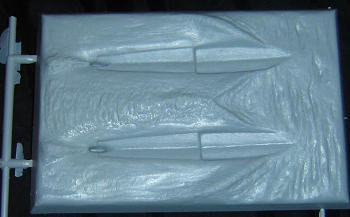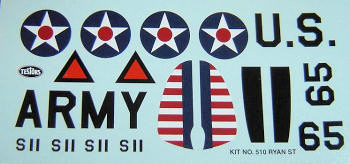Testors/Hawk 1/48 Ryan PT-20 Trainer
|
KIT: |
Testors/Hawk 1/48 Ryan PT-20 Trainer |
|
KIT #: |
7510 |
|
PRICE: |
NZ $26.95
|
|
DECALS: |
Two options |
|
REVIEWER: |
Zac Yates |
|
NOTES: |
Both land and floatplane options |

The
Ryan ST
series of aircraft is truly one of those timeless designs that never fails to
produce an admiring gasp from the viewer. Originally built to serve as a civil
trainer, the Ryan ST (Sport Trainer) was developed into the STA (Aerobatic) and
STM (Military) variants, with examples being procured by not only the USAAC but
also the air arms of the Netherlands,
Bolivia,
Ecuador,
Guatemala,
Honduras,
Mexico,
Nicaragua and Nationalist
China. 34 of the surviving Netherlands East Indies aircraft were “evacuated” to
Australia,
whereupon they joined the Royal Australian Air Force. Many of these machines
survive – happily in flying condition – not only in
Australia
but also the
USA
and a single example in
New Zealand.
With development
of a wider fuselage, stronger undercarriage, wings with slight sweepback and a
more powerful Kinner radial engine, the ST-3KR (PT-22 Recruit) came into being,
this surviving in far greater numbers than her more shapely older sibling.
For many people
the ST series is pretty much a “trademark” Art Deco design, and thanks to its
glamorous image will no doubt be flying well past its hundredth year.
 As
far as injection-moulded kits go, the Testors PT-20 (or earlier Hawk boxing) is
the only game in town. There is a Rareplanes vacuform STM available in 1:72, and
judging by another Rareplanes vac I built some time ago would build very nicely.
However, this is NOT a review of the RP kit!
As
far as injection-moulded kits go, the Testors PT-20 (or earlier Hawk boxing) is
the only game in town. There is a Rareplanes vacuform STM available in 1:72, and
judging by another Rareplanes vac I built some time ago would build very nicely.
However, this is NOT a review of the RP kit!
Upon receipt of
your sturdy side-opening brown box (with a lovely photo of completed model “on
the bench”) you see five sprues of light grey styrene with a fair amount of
flash on several parts. One of these sprues is devoted to a s ingle
part: a very nice “water” base, complete with cutouts for the optional floats
included in the kit. This makes displaying the floatplane a much easier task if,
like me, you’ve not made your own water base before. The floats option even
comes with beaching wheels, although there are some sink marks on the tires that
would likely be very hard to remove. For the other, wheeled option, you get
those natty spats which lend that unmistakeable Art Deco mystique to the inline
Ryans. Parts count is less than 40, with a one-piece wing (thankfully with
dihedral moulded in!) and two small windscreens (mine are crazed for some
reason, so I have to scrounge some replacements). The exhausts for the Menasco
Pirate engine are four small separate items, about the most fiddly parts in the
entire kit!
ingle
part: a very nice “water” base, complete with cutouts for the optional floats
included in the kit. This makes displaying the floatplane a much easier task if,
like me, you’ve not made your own water base before. The floats option even
comes with beaching wheels, although there are some sink marks on the tires that
would likely be very hard to remove. For the other, wheeled option, you get
those natty spats which lend that unmistakeable Art Deco mystique to the inline
Ryans. Parts count is less than 40, with a one-piece wing (thankfully with
dihedral moulded in!) and two small windscreens (mine are crazed for some
reason, so I have to scrounge some replacements). The exhausts for the Menasco
Pirate engine are four small separate items, about the most fiddly parts in the
entire kit!
For the interior
you get two crew members and a floor. That’s it. Now I’ve read one online review
of this kit damning Testors for making it so crude. Well, it IS a 1960s mould
and to be honest I’m not too sure how well the kit sells. I’d like to imagine it
ranks with the Tamiya F-16s in terms of interest and customer base, but I think
not. Perhaps one of the European companies could step up to the plate with a new
tool version? Anyway, the same reviewer said this kit was quite similar to
Eastern European limited-run kits, which is I think a little harsh but still
accurate to a degree. So for an accurate cockpit you will have to turn to your
spares box and resources, as well as things such as venturi tubes and turnover
truss.
Based on photos
and video of STs I’ve seen, this kit appears to be quite accurate. For a kit of
its age the rivet detail is pretty much spot on and to scale, and there’s none
of that god-awful “fine fabric detail” on the control surfaces and wings. Memo
to those who like that sort of “detail”: when you’ve been around fabric-covered
aircraft as much as I have, you don’t notice the fabric patterns! Even close up,
IT’S SMOOTH! Rant over.
The instructions
have only four, easy-to-follow steps with colour callouts in Testors and Model
Master paint numbers. There’s a great little aircraft bio, as well as hints for
prep and building. Well done Testors! HOWEVER, one major part of the ST that
can’t go  unnoticed
even on a small kit like this is the rigging. The boxtop and instruction header
show this in place, but it is mentioned nowhere in the instructions. Mind you,
with the Power Of The Internet this is no biggie as there’s no shortage of
top-quality images of the real thing out there.
unnoticed
even on a small kit like this is the rigging. The boxtop and instruction header
show this in place, but it is mentioned nowhere in the instructions. Mind you,
with the Power Of The Internet this is no biggie as there’s no shortage of
top-quality images of the real thing out there.
The beautifully
printed decals give you two options, a USAAC aircraft #65 and a Netherlands East
Indies floatplane S11. I doubt there’s any Ryan-specific decal sheets out there,
but for most schemes all you’d need would be national marks and serials anyway.
Of course, if you want (like me) to do a civil machine then you only require a
lettering sheet!
As
part of the lead-up to acquiring this kit, I’ve spent a while researching the
real thing. Thanks to magazines, airshow DVDs and the internet – as well as the
few occasions I’ve seen REAL Ryans up close! – I have a bit of a grasp for this
lovely type, and so the build will be a great exercise in detailing to “get it
right”. This kit has it all about right, and at the price (and size – span of
less than 7in) would be a great addition to any collection. Bizarrely I’ve only
seen two of these built up on the net… She can be built as a weekend project
with your young folk, or superdetailed as you see fit.
I’ll be doing
the latter. Watch this space!
Zac Yates
June 2008
Review kit
courtesy of my ATM card.
If you would like your product reviewed fairly and quickly, please
contact
me or see other details in the
Note to
Contributors.
Back to the Main Page
Back to the Previews Index Page


 As
far as injection-moulded kits go, the Testors PT-20 (or earlier Hawk boxing) is
the only game in town. There is a Rareplanes vacuform STM available in 1:72, and
judging by another Rareplanes vac I built some time ago would build very nicely.
However, this is NOT a review of the RP kit!
As
far as injection-moulded kits go, the Testors PT-20 (or earlier Hawk boxing) is
the only game in town. There is a Rareplanes vacuform STM available in 1:72, and
judging by another Rareplanes vac I built some time ago would build very nicely.
However, this is NOT a review of the RP kit! ingle
part: a very nice “water” base, complete with cutouts for the optional floats
included in the kit. This makes displaying the floatplane a much easier task if,
like me, you’ve not made your own water base before. The floats option even
comes with beaching wheels, although there are some sink marks on the tires that
would likely be very hard to remove. For the other, wheeled option, you get
those natty spats which lend that unmistakeable Art Deco mystique to the inline
Ryans. Parts count is less than 40, with a one-piece wing (thankfully with
dihedral moulded in!) and two small windscreens (mine are crazed for some
reason, so I have to scrounge some replacements). The exhausts for the Menasco
Pirate engine are four small separate items, about the most fiddly parts in the
entire kit!
ingle
part: a very nice “water” base, complete with cutouts for the optional floats
included in the kit. This makes displaying the floatplane a much easier task if,
like me, you’ve not made your own water base before. The floats option even
comes with beaching wheels, although there are some sink marks on the tires that
would likely be very hard to remove. For the other, wheeled option, you get
those natty spats which lend that unmistakeable Art Deco mystique to the inline
Ryans. Parts count is less than 40, with a one-piece wing (thankfully with
dihedral moulded in!) and two small windscreens (mine are crazed for some
reason, so I have to scrounge some replacements). The exhausts for the Menasco
Pirate engine are four small separate items, about the most fiddly parts in the
entire kit! unnoticed
even on a small kit like this is the rigging. The boxtop and instruction header
show this in place, but it is mentioned nowhere in the instructions. Mind you,
with the Power Of The Internet this is no biggie as there’s no shortage of
top-quality images of the real thing out there.
unnoticed
even on a small kit like this is the rigging. The boxtop and instruction header
show this in place, but it is mentioned nowhere in the instructions. Mind you,
with the Power Of The Internet this is no biggie as there’s no shortage of
top-quality images of the real thing out there.